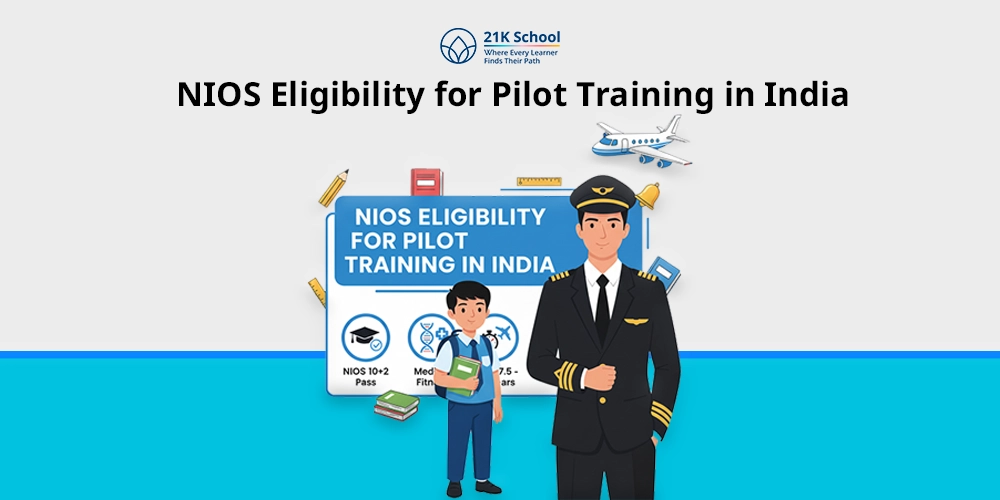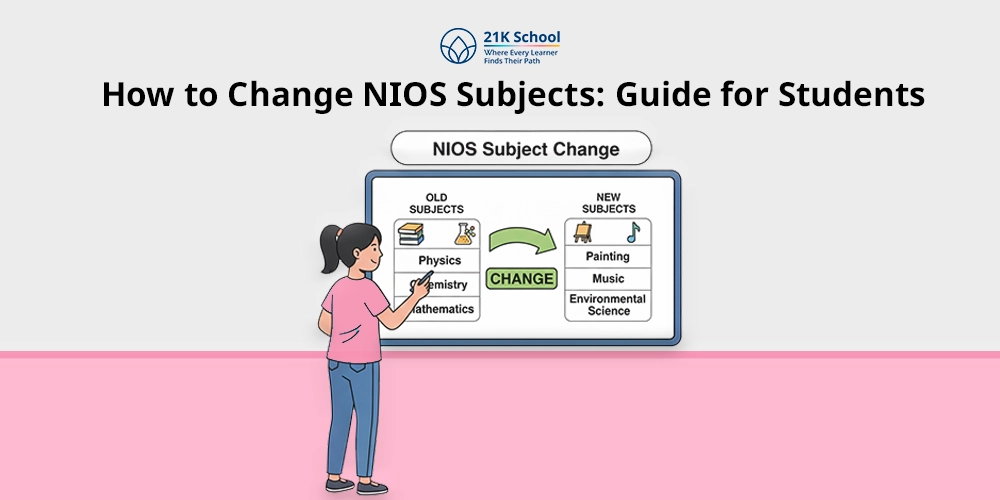
NIOS is the open schooling system which has high acceptance in India and abroad for its competent syllabus , testing methods, and resources.
And if you ever dreamt of being a commercial pilot, NIOS can be your path finder.
Students who left their thoughts of becoming a pilot due to incomplete higher secondary education, can knock on the doors of NIOS.
In this article, we shall find everything related to NIOS for pilots, steps needed to qualify, and challenges faced during the process of living up to this dream.
Contents
What is NIOS for Pilots?
NIOS for pilots means that you finish your senior secondary (Class 12) education using NIOS for being a pilot in future.
This would be with courses in Physics and Mathematics that are compulsory to enter the pilot training schemes.
It should also be acknowledged by the Directorate General of Civil Aviation (DGCA).
Why NIOS for Pilot Training?
Learners who attended school in non-science streams or boards, did not offer flexibility in necessary combinations of subjects. Due to this, they feel left out and fear of leaving their dreams.
Therefore, many students resort to NIOS for piloting as a way of meeting the requirements of the DGCA eligibility criteria.
It is via this route that students are allowed to take exams, score marks and get a valid Class 12 certificate that is accepted by all aviation academies both in India and overseas.
1. Educational Eligibility for Pilots in India
Indian students wishing to qualify to be licensed pilots need to fulfill academic qualifications as mandated by the DGCA.
These are both applicable to be a Commercial Pilot (CPL) or a Private Pilot (PPL).
The minimum requirements are:
- 10+2 or other board’s similar recognised qualification
- Courses in Physics and Mathematics are compulsory.
- Most flying schools require 50-51% in Physics and Mathematics individually, not just aggregate
[Many cadet programs like IndiGo require 51% in each subject (Physics, Mathematics, and English) individually.]
You would be unable to even take a pilot ground school course or even apply to a DGCA approved flying school without Physics and Mathematics.
2. How NIOS Helps?
NIOS can be really profiting for those students who:
- Missed studying Physics and Mathematics at school
- Unsatisfied with the marks gotten in the past and wishes to raise grades
- Have either an arts or business background, and would like to join the aviation profession.
- Requires flexibility because of work, traveling, or financial alternatives.
NIOS enables them to enroll in science stream, learn at their leisurely speed, and take exams two times every year (April and October).
The NIOS certificate, upon passing, is the same as that in case of CBSE, ICSE, or any state board to do DGCA verification.
Eligibility Requirements & Process via NIOS for Pilot Training
Let’s now have a look at the requirements and steps to become a pilot via NIOS for pilot training.
Step 1: Check Basic Pilot-License Criteria
Before going into NIOS, confirm basic DGCA eligibility:
- Required age would be 18 years to apply for a Student Pilot Licence (SPL).
- Should be medically fit as per DGCA Class 2 and Class 1 medical guidelines.
- Should have passed with 10+2 in Physics and Mathematics in a recognized board.
Step 2: Meet the 10+2 with Physics & Mathematics Requirement
In case you didn’t choose or complete these subjects during your prior education , you can have the option of studying them at the senior secondary level through NIOS.
You can either take five subjects (including Physics and Mathematics) in case of fresh admission, or can have reimbursement of up to two subjects of your prior recognized board.
This makes you save yourself from repeating all subjects therefore saving time and effort.
Step 3: Choose the Right Stream / Block in NIOS
The NIOS admission can be done in different blocks:
- Block I (April exams): Registration closes around September.
- Block II (October exams): Make registration as it closes around March.
To train as a pilot, you will have to enroll with the Senior Secondary (Class 12), Science Stream.
You must choose physics and mathematics in addition to other subjects such as English, Chemistry or Computer Science.
Step 4: Study & Clear the Subjects
NIOS has online courses, digital material, and textbooks.
You will have access to both English and Hindi study materials and thus you will be able to study anywhere.
To qualify, you must pass with at least 33 percent (theory and practical) and take the examinations which are conducted two times in a year.
The NIOS requires 33% to pass, but flying schools and cadet programs typically require a 51% minimum in NIOS subjects for admission, not just passing marks.
Step 5: Apply for DGCA Ground Classes & Flying Training
On clearing NIOS Class 12 with the presence of Physics and Mathematics you may pursue courses in DGCA approved ground school like Air Navigation, Air Regulation and Meteorology.
Once you clear those theory papers and medicals, you can join a flying training organization (FTO) to accomplish the necessary 220 flight hours.
Step 6: Choose Your License Route
Since you have trained to work in the field, you may apply for:
- Student Pilot Licence (SPL): Entry level licence for newbies
- Private Pilot Licence (PPL): Personal flying under no commercial purpose (not commercial air operations)
- Commercial Pilot Licence (CPL): In the case of professional jobs in the flying field.
The academic requirement of the three pathways is met by the NIOS qualification.
NIOS for Pilot: Things to Keep in Mind / Challenges
The challenges for NIOS for pilot include achieving minimum marks, best stream choice, costs management, and required aptitude tests:
1. Minimum Marks / Percentages
NIOS is content with certifications of 33 percent in each subject.
What is different is the DGCA eligibility criteria for admissions and scholarships in pilot training programs.
The requirement of marks reach 51% or even more individually in physics and maths subjects.
2. Stream Choice & Subject Count
Although physics and mathematics are needed, NIOS has five subjects altogether.
To your surprise though, DGCA is planning to remove physics and maths from their CPL training requirement of 2025.
Other than these two, you are allowed to choose two other electives in addition to English.
These subjects choices should be avoided if exams are overlapping or have huge amounts of practical work assignments.
3. Credit Transfer / Combining Certificates
NIOS permits transfer of two subjects of other recognized boards on credit.
You are therefore able to make your 10+2 easier to complete without starting from the beginning.
All you need to do in such a situation is to ensure all subjects are cleared in five years of first registration.
4. Costs
NIOS is cheap as compared to the education in private schools. On average admission fees are a few hundred per subject.
The coaching for maths or physics would range between ₹8K – ₹15K including materials and exam fees.
Still the cost of pilot training per se, which follows NIOS 2025, could be ranging between ₹40-60 lakhs for CPL alone.
With type rating adding another ₹15-25 lakhs, totaling ₹55-85 lakhs for getting a commercial pilot licence.
And this is based on the flying school and hours in the air.
5. Medical & Aptitude Tests
The only requirement to clear 10+2 is still less.
You will also have to succeed in medical examinations DGCA Class 2 and Class 1, or tests of eyesight, hearing and cardiovascular system and fitness in general.
Besides, flight schools might also demand an intelligence test or a psychological assessment .
6. Time Management & Discipline
NIOS is flexible, although student discipline is still required to shape commercial pilots’ habits.
The foundation for any pilot’s growth stays in their ability to manage time and their tight schedule.
Therefore, despite having a lenient time table with NIOS, learners need to be serious about their real development of time-management skills.
Conclusion
NIOS is a boon for a student choosing to be a pilot as their career.
NIOS for pilots is simple and attainable for even those learners who have not completed their studies in class 12.
DGCA has a list of check points in academics as well as in physical tests.
Though the costs are minimal for NIOS subjects, it is still high for CPL training and licence.
Anybody with the right direction from the given article can decide if they would like to choose NIOS for pilots or not.



